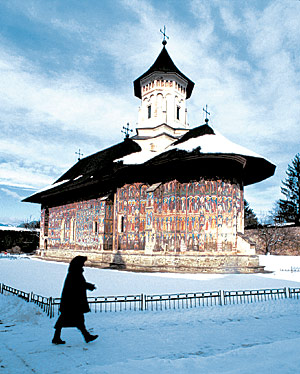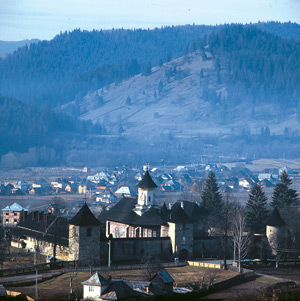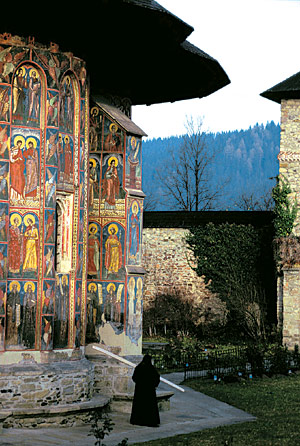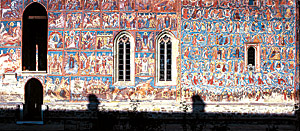Year Built: 1532
Built by: Prince Petru Rareş
Location: Vatra Moldoviţei, Suceava County
Summary: The most distinctive feature of the Church of the Annunciation is the open exonarthex with its three tall arches on the west façade. The exterior paintings are the best preserved of all the churches of Bucovina.

Alexander the Kind built the first monastery in Moldoviţa on the banks of the Moldoviţa River at the beginning of the 15th century. The site chosen was far from other villages, in the middle of the forest. He donated lands and Tartar slaves to the establishment, and the first community around the compound was created. The monastery is mentioned for the first time in a document of 1402, and successive other documents tell of new donations. There is no record of how, or when, the monastery was destroyed, but possibly an earthquake ruined it at the beginning of the 16th century.
Only low stone ruins remain of the first church. It was built of rough blocks of stone on a triconch plan, with three apses. Originally, it had only a chancel, a naos and a narrow pronaos. When the monastic community increased in size, a second, much larger, pronaos was built to the west end of the edifice. As is the case with many other monasteries built during the first century of Moldavia’s existence, such as Probota and Humor,Moldovita was also re-founded by Petru Rareş. The new church was built in 1532 in a different location, several hundred metres uphill from the river.

Petru Rareş founded the present Church of the Annunciation, as is confirmed by the commemorative inscription on the south façade of the church, to the left of the entrance. The church is built on the usual triconch plan of three apses used for all monastic establishments. The church is rather long, as it has, besides the obligatory chancel, naos and pronaos, a burial chamber and an exonarthex. A graceful octagonal lantern tower with four windows stands above the naos, and a hidden treasury room was built above the burial chamber. The open exonarthex with large openings is its most distinctive feature, built on the model of the Church of Humor.
The long façades are smooth, except for a row of small niches that surrounds the whole church. The three apses are decorated with tall niches that reach almost to the eaves. The four big pronaos windows have pointed Gothic arches and stone tracery in the upper part. The other five windows are much smaller, with slightly pointed arches and a square frame of crossed rods.

The church was painted in 1537 both inside and outside. The significant stylistic differences between various scenes indicate that there must have been several painters at work in Moldoviţa.
In 1607 Bishop Efrem of Rădăuţi built the solid precinct wall with three towers. The gate tower and the southeast corner tower are square, but the northeast corner tower is round. A vaulted gateway leads through the gate tower into the compound. The arch of the gateway is decorated with carved stone rosettes. In the northwest corner of the compound is a two-storey building, the former clisiarniţa, or treasury house. Now the building is the monastery museum. The collection includes embroideries, icons, liturgical books, archaeological finds and the church seat of Petru Rareş.The exterior painting of the Church of the Annunciation is the best preserved among all the painted churches of Bucovina. Especially on the south and east façades, there are paintings that have not been faded by the passage of time, and that are able to suggest how bright the decorated façades were during the reign of Prince Rareş.
Just under the eaves are 105 niches, each painted with an angel. On the western pillar, just to the left of the entrance and the tall opening of the south façade, there are three Military Saints on prancing horses and with either a lance or a sword in hand. Farthest up is St. George, then St. Demetrius and St. Mercurius.

On the south façade is the Akathistos Hymn as usual. The 24 stanzas of the Hymn cover four registers. First come the twelve historical stanzas that recount the birth of Christ: The Annunciation, The Conception, The Virgin Mary Meets St. Elizabeth, The Doubting of Joseph, The Birth of Christ, The Way of the Three Magi to Bethlehem, The Adoration of the Magi, The Return of the Three Magi, The Flight to Egypt, and The Presentation of Jesus at the Temple.
Moldovita Monastery is 27 km north of Câmpulung Moldovenesc. In Câmpulung Moldovenesc you can find accommodations and travel information. Câmpulung Moldovenesc is 72 km from Suceava on E58. Suceava can be reached on the main European roads E85, E58, but also on the railway Bucharest-Chernivtsi-Lvov or by air. The city has an airport with flights to Bucharest and even abroad.

Niciun comentariu:
Trimiteți un comentariu